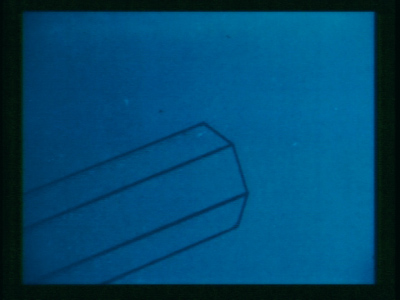

1968, USA, 16mm, colour, sound, 5 min.
Breer’s next film, 69, deals directly with depth illusions and achieves its color effects by almost completely reducing the film to black-and-white. The background for shapes is again white, except when the film slowly fades toward dark gray or tints the whole surface blue. Against this whiteness the outline figures of a hexagonal column, a wheel, a beam, and a door seem to sweep onto the screen from an off-screen axis and move through the screen’s cubic space in depth. The column, which is the first and the pace-setting form, cuts through the lower left-hand edge of the frame and disappears in depth as if it sliced through our field of vision for a section of its circular movement. The door appears to swing inward from a base at the bottom of the screen. The plank moves like the column, but outward, hinged at the lower right, and the wheel alone crosses the screen horizontally without emerging or receding in depth. The film derives its major rhythm from the pacing of these four periodic movements. At first they are intercut in different combinations. At their most intense, all four flicker together with one frame apiece.
P. Adams Sitney from Visionary Film, Oxford University Press, p. 282
